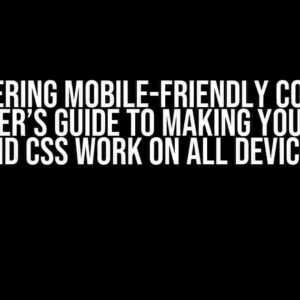Are you tired of seeing those pesky .php extensions in your website’s URLs? Do you want to improve the security and aesthetics of your online presence? Look no further! In this comprehensive guide, we’ll explore the best way to deny .php in URLs while keeping access to those files through other URLs. Buckle up, and let’s dive into the world of URL rewrites!
Why Deny .php in URLs?
Before we dive into the solution, let’s discuss the importance of hiding .php extensions in URLs. Here are a few compelling reasons:
- Security**: Exposing .php extensions can make your website vulnerable to attacks. Savvy hackers can exploit PHP vulnerabilities, putting your entire site at risk.
- SEO**: Search engines tend to favor URLs without extensions, as they appear more user-friendly and clean.
- User Experience**: Let’s face it – .php extensions can look ugly and detract from your website’s professional image.
The Solution: URL Rewrites with Mod_Rewrite
Apache’s mod_rewrite module is the perfect solution for denying .php in URLs while keeping access to those files through other URLs. This powerful tool allows you to rewrite URLs, hiding .php extensions and improving your website’s overall appearance.
Step 1: Enable Mod_Rewrite
To start, you’ll need to enable mod_rewrite on your Apache server. You can do this by adding the following lines to your .htaccess file:
RewriteEngine On
RewriteBase /This will activate mod_rewrite and set the rewrite base to your website’s root directory.
Step 2: Create Rewrite Rules
Next, you’ll need to create rewrite rules that will hide .php extensions from URLs. Add the following code to your .htaccess file:
# Remove .php extension
RewriteCond %{REQUEST_FILENAME} !-d
RewriteCond %{REQUEST_FILENAME}\.php -f
RewriteRule ^([^\.]+)$ $1.php [L]This code does the following:
RewriteCond %{REQUEST_FILENAME} !-d: Ensures the request is not for a directory.RewriteCond %{REQUEST_FILENAME}\.php -f: Checks if a .php file exists with the same name as the requested URL.RewriteRule ^([^\.]+)$ $1.php [L]: Rewrites the URL by removing the .php extension and appending it internally.
Step 3: Test Your Rewrite Rules
Now that you’ve created the rewrite rules, it’s time to test them. Try accessing a page on your website that has a .php extension, such as example.php. If the rewrite rules are working correctly, you should be able to access the page without seeing the .php extension in the URL.
Common Scenarios and Solutions
In this section, we’ll cover some common scenarios where .php extensions might still be visible and provide solutions to overcome them.
Scenario 1: PHP Files in Subdirectories
If you have PHP files in subdirectories, the rewrite rules might not work as expected. To solve this issue, you can add the following code to your .htaccess file:
# Recursive rewrite for PHP files in subdirectories
RewriteRule ^(.*)/(.*)$ $1/$2.php [L]This code rewrites URLs with subdirectories, ensuring that .php extensions are hidden.
Scenario 2: PHP Files with Query Strings
If you have PHP files with query strings, the rewrite rules might not remove the .php extension correctly. To fix this, you can add the following code to your .htaccess file:
# Remove .php extension with query strings
RewriteRule ^([^\.]+)\?(.*)$ $1.php?$2 [L]This code rewrites URLs with query strings, hiding the .php extension.
Best Practices and Considerations
When using mod_rewrite to hide .php extensions, keep the following best practices and considerations in mind:
- Test Thoroughly**: Ensure that your rewrite rules are working correctly by testing various scenarios and URLs.
- Avoid Conflicting Rules**: Make sure that your rewrite rules don’t conflict with each other or with other .htaccess directives.
- Use Rewrite Logs**: Enable rewrite logs to debug and troubleshoot any issues with your rewrite rules.
- Keep Your .htaccess Clean**: Organize your .htaccess file and avoid redundant or unnecessary code.
Conclusion
In conclusion, denying .php in URLs while keeping access to those files through other URLs is a valuable technique for improving your website’s security, SEO, and user experience. By following the steps outlined in this article, you can hide .php extensions using mod_rewrite and enjoy the benefits of clean, user-friendly URLs.
| Keyword | Description |
|---|---|
| mod_rewrite | Apache’s URL rewriting module |
| RewriteEngine | Activates mod_rewrite |
| RewriteBase | Sets the rewrite base directory |
| RewriteCond | Specifies conditions for rewriting URLs |
| RewriteRule | Defines the rewrite rule itself |
By mastering URL rewrites and hiding .php extensions, you’ll be able to take your website to the next level and provide a better experience for your users. Happy rewriting!
Frequently Asked Question
Looking for ways to deny access to .php files in your URLs while keeping access to those files through other URLs? You’re in luck! We’ve got the answers you’re looking for.
Why do I need to deny access to .php files in my URLs?
Denying access to .php files in your URLs can improve the security of your website by preventing hackers from exploiting vulnerabilities in your code. It also helps to reduce the risk of information disclosure, as .php files often contain sensitive data.
How can I deny access to .php files in my URLs using .htaccess?
You can deny access to .php files in your URLs by adding the following code to your .htaccess file: <Files ~ "\.php$"> Order Allow,Deny Deny from all</Files>. This will prevent direct access to .php files, while still allowing your website to function normally.
What if I need to allow access to specific .php files?
If you need to allow access to specific .php files, you can modify the .htaccess code to include an exception. For example, to allow access to a file named myfile.php, you can add the following code: <Files ~ "myfile\.php"$> Order Deny,Allow Allow from all</Files>. This will allow access to the specified file, while still denying access to other .php files.
Will denying access to .php files affect my website’s performance?
Denying access to .php files should not significantly impact your website’s performance, as the .htaccess code only blocks direct access to the files. Your website will still be able to function normally, and any legitimate requests will be processed as usual.
Are there any alternative methods to deny access to .php files?
Yes, there are alternative methods to deny access to .php files, such as using a web application firewall (WAF) or a content delivery network (CDN) with built-in security features. However, the .htaccess method is a simple and effective way to achieve this goal.




